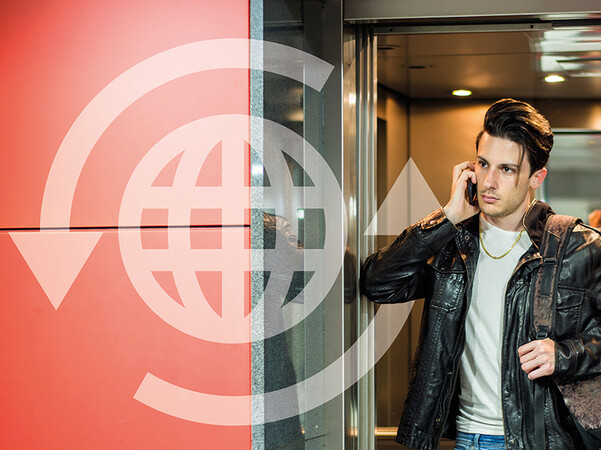Modernisation instead of new lifts: The sustainable way
There are currently about 6.5 million lifts in existence in Europe - and every year about 150,000 new lifts are put into operation (source: ELA - European Lift Association).
Whereas these new lifts used to be installed almost exclusively in new buildings or new shafts, in recent years the proportion of new lifts installed in existing shafts has continuously increased as "complete modernisation".
By Frank Schmidt
The reasons appear to be obvious: by a complete replacement, a lift can be brought up to the state of the art all at once both in terms of safety as well as energetically. But is this approach correct?
Let us consider the complete replacement in terms of energy, raw materials and time.
• At first glance, complete replacement often appears to be attractive, since the amount of energy that the lift needs for operation seems to fall by several hundred kWh per year.
• This is counterbalanced by the heavy use of raw materials – and of energy for their procurement. If one estimates a primary energy use of 5 MWh for one ton of steel and 25 MWh for a ton of aluminium, takes into account in addition the rare earths required and precious metals involved, it is clear that a complete replacement is often not sustainable. (Source for figures: EPD platform of the IBU, "Institut Bauen und Umwelt e.V.", Berlin It should be borne in mind here that the raw material extraction and refinement stages of the above-mentioned primary energy uses was not included in the consideration.)
• When looking at the statistical figures of the ELA mentioned at the outset, it can be seen that given 150,000 new lifts, it would take over 60 years to replace all of the lifts in Europe once, provided two-thirds of these 150,000 new lifts replaced exclusively existing lifts!
 Photo: © DeanDrobot/iStock/Montage
Photo: © DeanDrobot/iStock/MontageWhen these three points are considered and the responsibility of the lift industry and operators to achieve the global climate targets, it is clear that modernisation of existing lifts is frequently the more sustainable and efficient method.
The advantages of preferring modernisation to complete replacement are:
• Many of the components, which due to their mass and raw materials bind a high proportion of resources and primary energy (e.g., rails, counterweight) can remain in the shaft
• The on-site adjustments and raw materials required for them (such as cement) and energy are reduced
• Compared to a new lift, there is less noise and dust
• The time for conversion and associated restriction of mobility in the building involved, especially for users with physical handicaps, is nowhere near as great
• A modernisation measure offers a lower "financial hurdle" than complete replacement
• For those responsible for several lifts, modernisation provides the option of renovating more lifts with the existing budget than would be possible with complete replacement
But what do things look like in practice? What is driving the modernisation market?
Modernisations were heavily impelled by safety aspects for a long time. This included retrofitting car doors, systems to prevent overspeed upwards, emergency call systems or the famous "Amendment 3" to EN 81-1, today still known as "A3 systems" due to the UCM installations and much more. Regulations arose in relation to these modernisations, such as EN 81-80 (also "Safety Norm for Existing Lifts" or SNEL for short), the conversion catalogue of the German Committee for Lifts and many more. But they all concentrated on safety in the main.
 Photo: © heartofphoto/123RF.com
Photo: © heartofphoto/123RF.comBut what is happening around us? What (mega-) trends and topics are shaping our society today more than twenty years ago? And which of these can be applied to the operation of lifts?
The movement towards neo-ecology with its sustainability approach must be brought into harmony with the social challenges of individualisation, urbanisation and (over-) aging of our society, which poses new requirements in terms of accessibility. This makes it clear that apart from safety aspects, ecology and barrier-freedom are and must also be the drivers in modernising lifts.
Based on this perspective, the "Working Group SAEL" was set up by the ELA, the European Lift Association. It deals with the safety, barrier-freedom (accessibility), ecology (energy performance) of existing lifts and attempts to find approaches how modernisations can make equal allowance for these subject areas.
Safety – accessibility – ecology.
A magical triangle without a solution? By no means! Many modernisation measures for lifts support at least two, often three, of these goals. Retrofitting frequency control is a simple example of this: it lowers the travel energy requirements (ecology) of a lift and makes a contribution to greater safety and accessibility with enhanced stopping precision and the associated reduced step formation.
Based on this perspective, a new "modernisation catalogue" arose via the ELA, which presents a series of options on how many of the 6.5 million lifts in Europe can be operated more safely, accessibly and energy efficiently with modernisations. This catalogue is far from being comprehensive. The range of existing lifts and technical solutions is simply too great. But it provides examples of how certain goals can be achieved with selected solutions. It is up to us experts to follow this approach and find more solutions for specific lifts in order to be also able to operate lifts in future safely, accessibly and sustainably.
Of course, complete replacement also plays a role in the SAEL catalogue, because it is by no means to be condemned – sometimes there are good reasons not to modernise but replace completely. However, in most cases the advantages of adjusting lifts to current technologies and requirements through modernisations are predominant.
The author is the head of development at the Aufzugswerken Schmitt+Sohn in Nuremberg, member of DAfA, in technical committees at the VDMA and in the ELA co-author of the "SAEL White Paper" of the ELA.
More information:The english version of the SAEL White Paper


























Write a comment